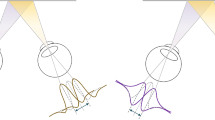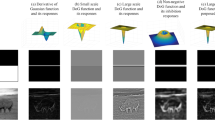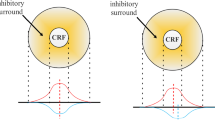Abstract
The human visual system has efficient architecture for information reception and integration for effectively performing visual tasks like detecting contours. Physiological evidence has shown that most neuronal responses in the classical receptive field (CRF) of the primary visual cortex are modulated, generally suppressed by the non-CRF surround. These center-surround interactions are thought to inhibit or facilitate responses to edges according to other similar edges in the surroundings, which is useful for suppressing textures and enhancing contours. A biologically motivated model with subfield-based inhibition is proposed in this paper to improve the performance of perceptually salient contour detection relative to the existing single-neuron based inhibition model. A novel subfield based inhibition framework is presented, where the inhibition terms are combined with center-surround and surround-surround differences using multiple cues, including orientation based energy distribution and directional saliency within regions. Extensive experimental evaluation demonstrates that the proposed method outperforms most of competing methods, especially biological motivated ones.













Similar content being viewed by others
References
Albright TD, Stoner GR (2002) Contextual influences on visual processing. Annu Rev Neurosci 25(1):339–379
Angelucci A, Bressloff PC (2006) Contribution of feedforward, lateral and feedback connections to the classical receptive field center and extra-classical receptive field surround of primate V1 neurons. Prog Brain Res 154:93–120
Arbelaez P, Maire M, Fowlkes C, Malik J (2011) Contour detection and hierarchical image segmentation. IEEE Trans Pattern Anal Mach Intell 33(5):898–916. https://doi.org/10.1109/TPAMI.2010.161
Arbeláez P, Pont-Tuset J, Barron JT, Marques F, Malik J (2014) Multiscale combinatorial grouping. IEEE Conference on Computer Vision and Pattern Recognition:328–335
Azzopardi G, Petkov N (2012) A CORF computational model of a simple cell that relies on LGN input outperforms the Gabor function model. Biol Cybern 106:1–13
Bar M (2004) Visual objects in context. Nat Rev Neurosci 5(8):617–629
Bertasius G, Shi J, Torresani L (2015) Deepedge: a multi-scale bifurcated deep network for top-down contour detection. In: IEEE conference on computer vision and pattern recognition, pp 4380–4389
Boukerroui D, Noble JA, Brady M (2004) On the choice of band-pass quadrature filters. Journal of Mathematical Imaging and Vision 21(1–2):53–80
Bredfeldt CE, Ringach D (2002) Dynamics of spatial frequency tuning in macaque V1. J Neurosci 22(5):1976–1984
Canny J (1986) A computational approach to edge detection. IEEE Transactions on Pattern Analysis and Machine Intelligence 6:679–698. https://doi.org/10.1109/TPAMI.1986.4767851
Cao YJ, Lin C, Pan YJ, Zhao HJ (2019) Application of the center–surround mechanism to contour detection. Multimed Tools Appl 78(17):1–21
Cavanaugh JR, Bair W, Movshon JA (2002) Selectivity and spatial distribution of signals from the receptive field surround in macaque V1 neurons. J Neurophysiol 88(5):2547–2556
Chao-Yi L, Wu L (1994) Extensive integration field beyond the classical receptive field of cat's striate cortical neurons—classification and tuning properties. Vis Res 34(18):2337–2355
Coen-Cagli R, Dayan P, Schwartz O (2012) Cortical surround interactions and perceptual salience via natural scene statistics. PLoS Comput Biol 8(3):e1002405
Comaniciu D, Meer P (2002) Mean shift: a robust approach toward feature space analysis. IEEE Trans Pattern Anal Mach Intell 24(5):603–619
Cour T, Benezit F, Shi J (2005) Spectral segmentation with multiscale graph decomposition. Computer vision and pattern recognition, 2005. In: IEEE computer society conference on, vol 2. CVPR, pp 1124–1131
Croner LJ, Kaplan E (1995) Receptive fields of P and M ganglion cells across the primate retina. Vis Res 35(1):7–24
Das A, Gilbert CD (1999) Topography of contextual modulations mediated by short-range interactions in primary visual cortex. Nature 399(6737):655–661
Daugman JG (1985) Uncertainty relation for resolution in space, spatial frequency, and orientation optimized by two-dimensional visual cortical filters. JOSA A 2(7):1160–1169
Dollar P, Tu Z, Belongie S (2006) Supervised learning of edges and object boundaries. CVPR 2:1964–1971
Duda RO, Hart PE (1973) Pattern classification and scene analysis. Wiley, New York
Gao S, Yang K, Li C, Li Y (2013) A color constancy model with double-opponency mechanisms. ICCV:929–936
Girshick R (2015) Fast r-cnn. In: International Comference on computer vision, pp 1440–1448
Grigorescu C, Petkov N, Westenberg MA (2003) Contour detection based on nonclassical receptive field inhibition. IEEE Transactions on Image Processing 12(7):729–739. https://doi.org/10.1109/TIP.2003.814250
Hubel DH, Wiesel TN (1962) Receptive fields, binocular interaction and functional architecture in the cat's visual cortex. J Physiol 160(1):106–154
Hubel DH, Wiesel TN (1968) Receptive fields and functional architecture of monkey striate cortex. J Physiol 195(1):215–243
Hummel RA, Zucker SW (1983) On the foundations of relaxation labeling processes. IEEE Trans Pattern Anal Mach Intell 3:267–287
Itti L, Koch C (2000) A saliency-based search mechanism for overt and covert shifts of visual attention. Vis Res 40(10):1489–1506
Jones JP, Palmer LA (1987) An evaluation of the two-dimensional Gabor filter model of simple receptive fields in cat striate cortex. J Neurophysiol 58(6):1233–1258
Kass M, Witkin A, Terzopoulos D (1988) Snakes: active contour models. Int J Comput Vis 1(4):321–331
Krizhevsky A, Sutskever I, Hinton GE (2012) Imagenet classification with deep convolutional neural networks. Advances in Neural Information Processing Aystems:1097–1105
Landy MS, Graham N (2004) 73 visual perception of texture. The Visual Neurosciences 1106
Li C-Y (1996) Integration fields beyond the classical receptive field: organization and functional properties. Physiology 11(4):181–186
Li C-Y, Lei J-J, Yao H-S (1999) Shift in speed selectivity of visual cortical neurons: a neural basis of perceived motion contrast. Proc Natl Acad Sci 96(7):4052–4056
Lin C, Xu G, Cao Y, Liang C, Li Y (2016) Improved contour detection model with spatial summation properties based on nonclassical receptive field. Journal of Electronic Imaging 25(4):043018–043018
Maninis K-K, Pont-Tuset J, Arbeláez P, Van Gool L (2017) Convolutional oriented boundaries: from image segmentation to high-level tasks. arXiv preprint arXiv:1701.04658 40 (4): 819-833. https://doi.org/10.1109/TPAMI.2017.2700300
Marr D, Hildreth E (1980) Theory of edge detection. Proc R Soc Lond B Biol Sci 207(1167):187–217
Martin D, Fowlkes C, Tal D, and Malik J (2001) A database of human segmented natural images and its application to evaluating segmentation algorithms and measuring ecological statistics. Computer Vision, 2001. ICCV 2001. Proceedings. Eighth IEEE international conference on, vol. 2, pp. 416–423.
Martin DR, Fowlkes CC, Malik J (2004) Learning to detect natural image boundaries using local brightness, color, and texture cues. IEEE Trans Pattern Anal Mach Intell 26(5):530–549. https://doi.org/10.1109/TPAMI.2004.1273918
Papari G, Petkov N (2011) Edge and line oriented contour detection: state of the art. Image Vis Comput 29(2):79–103
Papari G, Petkov N (2011) An improved model for surround suppression by steerable filters and multilevel inhibition with application to contour detection. Pattern Recogn 44(9):1999–2007
Pont-Tuset J, Marques F (2016) Supervised evaluation of image segmentation and object proposal techniques. IEEE Trans Pattern Anal Mach Intell 38(7):1465–1478
Prewitt JM (1970) Object enhancement and extraction. Picture Processing and Psychopictorics 10(1):15–19
Series P, Lorenceau J, Frégnac Y (2003) The “silent” surround of V1 receptive fields: theory and experiments. Journal of Physiology-Paris 97(4):453–474
Shen ZM, Xu WF, Li CY (2007) Cue-invariant detection of Centre–surround discontinuity by V1 neurons in awake macaque monkey. J Physiol 583(2):581–592
Shen W, Wang X, Wang Y, Bai X, Zhang Z (2015) Deepcontour: a deep convolutional feature learned by positive-sharing loss for contour detection. In: IEEE conference on computer vision and pattern recognition, pp 3982–3991
Spratling MW (2013) Image segmentation using a sparse coding model of cortical area V1. IEEE Trans Image Process 22(4):1631–1643
Tang Q, Sang N, Zhang T (2007) Extraction of salient contours from cluttered scenes. Pattern Recogn 40(11):3100–3109
Tang Q, Sang N, Liu H (2016) Contrast-dependent surround suppression models for contour detection. Pattern Recogn 60:51–61
Walker GA, Ohzawa I, Freeman RD (2000) Suppression outside the classical cortical receptive field. Vis Neurosci 17(03):369–379
Wei H, Lang B, Zuo Q (2013) Contour detection model with multi-scale integration based on non-classical receptive field. Neurocomputing 103:247–262
Wei H, Dai Z-L, Zuo Q-S (2016) A ganglion-cell-based primary image representation method and its contribution to object recognition. Connect Sci 28(4):311–331
Xie S, Tu Z (2015) Holistically-nested edge detection. In: International comference on computer vision, pp 1395–1403
Xu W-F, Shen Z-M, Li C-Y (2005) Spatial phase sensitivity of V1 neurons in alert monkey. Cereb Cortex 15(11):1697–1702
Yang K, Gao S, Li C, Li Y (2013) Efficient color boundary detection with color-opponent mechanisms. In: IEEE Conference on Computer Vision and Pattern Recognition, pp 2810–2817
Yang K-F, Li C-Y, Li Y-J (2014) Multifeature-based surround inhibition improves contour detection in natural images. IEEE Trans Image Process 23(12):5020–5032
Yang K-F, Gao S-B, Guo C-F, Li C-Y, Li Y-J (2015) Boundary detection using double-opponency and spatial sparseness constraint. IEEE Trans Image Process 24(8):2565–2578
Yang K-F, Gao S-B, Li Y-J (2015) Efficient illuminant estimation for color constancy using grey pixels. CVPR:2254–2263
Yang K-F, Li H, Li C-Y, Li Y-J (2016) A unified framework for salient structure detection by contour-guided visual search. IEEE Trans Image Process 25(8):3475–3488
Zeng C, Li Y, Li C (2011) Center–surround interaction with adaptive inhibition: a computational model for contour detection. NeuroImage 55(1):49–66
Zeng C, Li Y, Yang K, Li C (2011) Contour detection based on a non-classical receptive field model with butterfly-shaped inhibition subregions. Neurocomputing 74(10):1527–1534
Acknowledgments
The authors appreciate the anonymous reviewers for their helpful and constructive comments on an earlier draft of this paper. This work was supported by the National Natural Science Foundation of China (Grant No. 61866002), Guangxi Natural Science Foundation (Grant No. 2020GXNSFDA297006 Grant No. 2018GXNSFAA138122 and Grant No. 2015GXNSFAA139293).
Author information
Authors and Affiliations
Corresponding author
Additional information
Publisher’s note
Springer Nature remains neutral with regard to jurisdictional claims in published maps and institutional affiliations.
Rights and permissions
About this article
Cite this article
Lin, C., Wen, ZQ., Xu, GL. et al. A bio-inspired contour detection model using multiple cues inhibition in primary visual cortex. Multimed Tools Appl 81, 11027–11048 (2022). https://doi.org/10.1007/s11042-022-12356-7
Received:
Revised:
Accepted:
Published:
Issue Date:
DOI: https://doi.org/10.1007/s11042-022-12356-7




